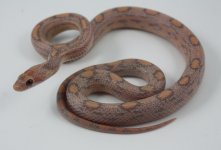ronlina
New member
Hi all!
I've last written on this forum in the snakes wanted section, looking for a retired adult snake to keep as a pet. Well, after searching for that so long to no avail and missing out on so many potential snakes, I decided to get a baby and be in it for the long haul after all.
So, of course I want the snake I couldn't afford 19 years ago when I first got into corn snakes: a lavender! But this morph has come a long way since then. I really love that purple cast, and lighter coloring rather than the darker, more grey-like coloring.
So, my questions:
I figure the answer could be that I can't tell and that's the fun of the lavender gene, but I also know that of all the places, this is the community to ask.
I'm looking on Morph Market and definitely open to breeders here, and found a few--they are both a darker mocha-brown from the images with very light/white-looking backgrounds, and I'm unsure if that is going to be more what I'm looking for, or less.
Thank you for any insight! And while I am looking for a snake now and open to any that may be available here, if you want to convince me to wait with your own stock or project plans, I'm open to that too
I've last written on this forum in the snakes wanted section, looking for a retired adult snake to keep as a pet. Well, after searching for that so long to no avail and missing out on so many potential snakes, I decided to get a baby and be in it for the long haul after all.
So, of course I want the snake I couldn't afford 19 years ago when I first got into corn snakes: a lavender! But this morph has come a long way since then. I really love that purple cast, and lighter coloring rather than the darker, more grey-like coloring.
So, my questions:
- Can I judge the baby snakes I'm seeing to guess at how they may change by the time they're an adult?
- If so, will darker saddles mean darker adults, whiter backgrounds mean greys will be prominant, or is that not a good measure?
- Will hets indicate any visible phenotype (for example, lavender het strawberry making for a very slightly pinkish lavender even though it's not a hypo?)
- Will images of the parents really indicate strongly what the hatchling will grow up to be? Or is that not very reliable?
I figure the answer could be that I can't tell and that's the fun of the lavender gene, but I also know that of all the places, this is the community to ask.
I'm looking on Morph Market and definitely open to breeders here, and found a few--they are both a darker mocha-brown from the images with very light/white-looking backgrounds, and I'm unsure if that is going to be more what I'm looking for, or less.
Thank you for any insight! And while I am looking for a snake now and open to any that may be available here, if you want to convince me to wait with your own stock or project plans, I'm open to that too

